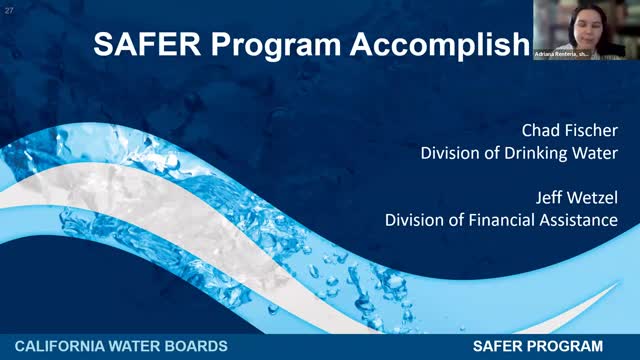SAFER program reports progress on 2019 failing systems, project phases and fund expenditure plan
January 03, 2025 | State Water Resources Control Board, Boards and Commissions, Executive, California
This article was created by AI summarizing key points discussed. AI makes mistakes, so for full details and context, please refer to the video of the full meeting. Please report any errors so we can fix them. Report an error »

State Water Board staff reviewed SAFER program metrics and the finalized 2024–25 Fund Expenditure Plan at the December 11 advisory group meeting, saying the board is standardizing project tracking and prioritizing funds for construction and technical assistance.
Division of Drinking Water supervising engineer Chad Fisher described three SAFER goals: (1) get people in communities without safe water back to safe water, prioritizing the 2019 cohort; (2) ensure all failing systems are on track for lasting solutions; and (3) reduce repeat failures by funding sustainable solutions such as consolidations. Fisher said the program developed a 10‑phase project tracker so staff and partners can measure project progress and identify bottlenecks.
Fisher presented a quarterly portfolio view showing recent progress in moving projects from planning to construction. He said the board is aiming to reduce the average return‑to‑compliance timeline (currently eight years or more for many failing systems) to five years, tighten project timelines with technical assistance, and improve enforcement so corrective action plans and compliance deadlines are uniform.
Division of Financial Assistance senior engineer Jeff Wetzel reviewed changes to the 2024 Fund Expenditure Plan that the board adopted after public comment. Major targets for the fiscal year include: $78 million for construction (capital projects and consolidations), $20 million for technical assistance (recently increased from $10 million), $10 million for interim supplies (split $5M failing/at‑risk and $5M for state smalls/domestic wells), $3 million for planning outside TA, and $1.5 million for administration. Wetzel said advanced‑pay guidelines for state‑funded projects are finalized to address cash‑flow barriers for small recipients.
Advisory members asked how the board will meet accelerated timelines. Fisher and Wetzel pointed to the new project‑phase tracking, inter‑division coordination, process improvements (a Lean‑6 review), expedited funding tracks and the board’s effort to prioritize projects most likely to yield durable outcomes. Members asked for clearer public reporting on phase timelines and for more emphasis on operations and maintenance (O&M) in certain cases.
Ending: Staff committed to report back with more detailed, project‑level timeline analysis and to bring draft materials to the advisory group in 2025; advisory members encouraged continued emphasis on durable solutions and O&M support where consolidation is not feasible.
Division of Drinking Water supervising engineer Chad Fisher described three SAFER goals: (1) get people in communities without safe water back to safe water, prioritizing the 2019 cohort; (2) ensure all failing systems are on track for lasting solutions; and (3) reduce repeat failures by funding sustainable solutions such as consolidations. Fisher said the program developed a 10‑phase project tracker so staff and partners can measure project progress and identify bottlenecks.
Fisher presented a quarterly portfolio view showing recent progress in moving projects from planning to construction. He said the board is aiming to reduce the average return‑to‑compliance timeline (currently eight years or more for many failing systems) to five years, tighten project timelines with technical assistance, and improve enforcement so corrective action plans and compliance deadlines are uniform.
Division of Financial Assistance senior engineer Jeff Wetzel reviewed changes to the 2024 Fund Expenditure Plan that the board adopted after public comment. Major targets for the fiscal year include: $78 million for construction (capital projects and consolidations), $20 million for technical assistance (recently increased from $10 million), $10 million for interim supplies (split $5M failing/at‑risk and $5M for state smalls/domestic wells), $3 million for planning outside TA, and $1.5 million for administration. Wetzel said advanced‑pay guidelines for state‑funded projects are finalized to address cash‑flow barriers for small recipients.
Advisory members asked how the board will meet accelerated timelines. Fisher and Wetzel pointed to the new project‑phase tracking, inter‑division coordination, process improvements (a Lean‑6 review), expedited funding tracks and the board’s effort to prioritize projects most likely to yield durable outcomes. Members asked for clearer public reporting on phase timelines and for more emphasis on operations and maintenance (O&M) in certain cases.
Ending: Staff committed to report back with more detailed, project‑level timeline analysis and to bring draft materials to the advisory group in 2025; advisory members encouraged continued emphasis on durable solutions and O&M support where consolidation is not feasible.
View full meeting
This article is based on a recent meeting—watch the full video and explore the complete transcript for deeper insights into the discussion.
View full meeting
